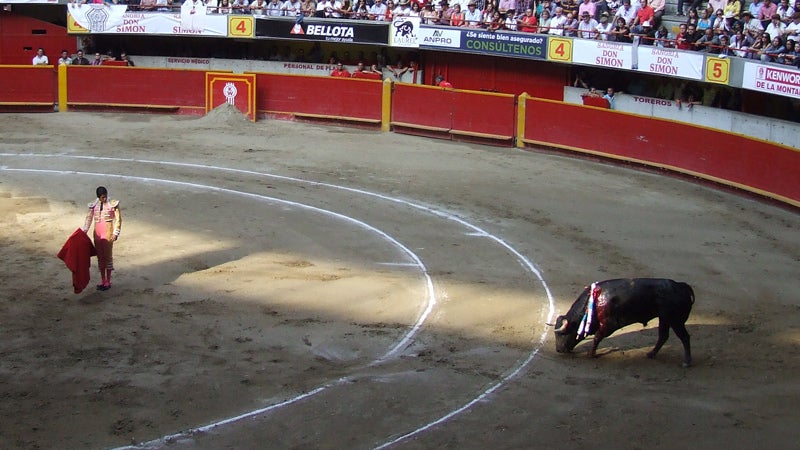Below a blue sky on a warm February afternoon, Santiago Gómez became the 168th matador in Colombian history. The 25-year-old from Colombia’s coffee country had trained for eight years before donning the “suit of lights,” a hand embroidered costume of pink and gold snug against his thin frame. An ornamental bolero covered his back, while a thin black tie matched a wavy tussle of hair that hung over his forehead. He wore black slippers, and tall pink socks hugged his calves.
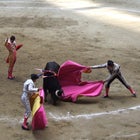 On his debut as a matador, Santiago Gomez calls for his bull to fall after he has plunged a sword in its back. Members of his cuadrilla seduce the bull in its final moments.
On his debut as a matador, Santiago Gomez calls for his bull to fall after he has plunged a sword in its back. Members of his cuadrilla seduce the bull in its final moments.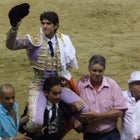 Frenchman Sebastian Castella waves to aficionados while riding triumphantly on the shoulders of a fellow bullfighter on the final day of Medellin’s 2014 bullfighting season.
Frenchman Sebastian Castella waves to aficionados while riding triumphantly on the shoulders of a fellow bullfighter on the final day of Medellin’s 2014 bullfighting season.The young man grew up across the street from the Plaza de Toros in Manizales, and had gone to the corridas with his father as a boy. He had long envisioned wearing this suit on the day of his alternativa, when a bullfighter becomes a matador.
Bullfighting is Colombia’s connection to its Spanish colonial past and its rural roots. “A festival without bulls is not a festival,” a Colombian saying goes. Small towns traditionally celebrate their anniversaries by setting up makeshift bull rings. The Colombian bullfighting season takes place each December through February, when the weather is warm and sunny and the cities of Manizales, Cali, and Medellín open the doors to their ornate palaces, hosting international bullfighters, local bands, and fervent aficionados from around the world.
But although cities such as Manizales can pack the house, nationally the industry cannot support itself. In Medellín, to the chagrin of aficionados, a retractable roof was added to the Plaza in 2003 to turn it into a concert venue. For the eighth and final bullfight of the season this year, prices were upwards of $80 and half the seats were empty. Although the number of fights per year has remained constant, Benjamin De Los Rios, plaza director for the past 23 years, said the 12,000-seat arena has averaged between 5,500 to 6,000 attendees per fight since the retirement of legendary fighter César Rincón in 2008.
Once shown on national television, Colombia’s great matadors were a source of national pride as they competed at home and abroad. But today, animal-rights activists protest bullfighting fervently, sometimes violently, and politicians campaign to end the tradition in their cities. A 2004 Colombian law protects bullfighting as an “artistic expression,” but mayors from large cities to small towns have found loopholes to effectively halt the spectacle. In Bogotá, for example, in 2012 the city’s embattled leftist mayor did not renew rights to use the ornate and celebrated Plaza de Toros de Santamaría, built in 1931.
For Gómez’s fight in Medellín on February 15, 110 police officers, including 36 riot police stood guard. Luckily, on this occasion, only about 30 college-aged students chanted from across the street, a line of policeman on horseback keeping a vigilant eye nearby. To Gómez, and many bullfighting aficionados, false rumors and accusations of torturing the animals before they enter the ring are the most unsettling. Gómez recently brought friends to watch him practice at the arena; he gave them a tour of the stalls, showed them the condition of the animals, and they left less doubtful than they’d arrived.
Unlike soccer matches, which are known for drunken brawls, bullfighting aficionados consider themselves a more sophisticated class. In the first class bullfighting rings, mostly well-heeled Colombians and foreigners from as far as Spain and France are in attendance; high prices prevent middle-class Colombians from attending.
In Medellín, Colombia’s fashion capital, men wear collared shirts, jeans, and boots to bullfights, often with the traditional Colombian sombrero vueltiao, a striped hat made of woven grass leaves died in black mud and sun-dried. The world-famous paisa women can be seen wearing rhinestone studded jeans and silk scarves. Many men and women carry a bota, a leather pouch filled with wine and slung over the shoulder.
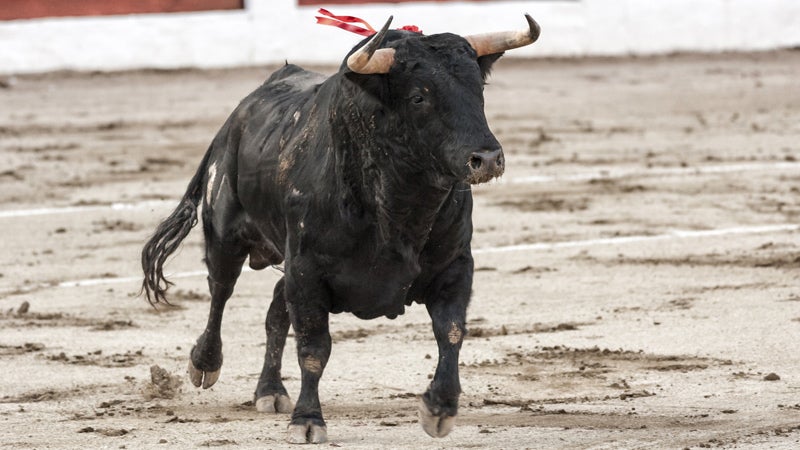
At 4:19 p.m. at the Plaza de la Macarena in Medellín, Gómez huddled near the edge of the arena with two great bullfighting legends. Standing akimbo in a light violet and gold suit was Frenchman Sebastian Castella, who lives in Cartagena with his Colombian wife and children. The Spaniard Morante de la Puebla, a stout bullfighter with a ponytail, wearing a suit of black and gold, embraced the young man and said to him: “If you respect the bull, it will respect you.” Gómez later said he was filled with emotion.
Then, a large red door swung inward and his first bull, a 1,022-pound black mammoth called Pipero, came tearing through the gate. In the middle of the silent ring, the animal kicked up sand, swung his tail, and fixed his gaze on the magenta and yellow capes flashed by other bullfighters from behind wooden barriers. Pipero charged toward one of them, slamming his horns into the barrier as the cape disappeared. The thud echoed in the arena.
Gómez stepped toward the center to give the bull its first pass. “Veronica! Otra Veronica!” a radio announcer called, describing the two-handed passes that Gómez gave whereby his feet and legs remained still while he slowly swung the cape away from the charging bull.
After the second of three acts, the young matador switched to the red muleta and walked across the length of the sand. He removed his montera, the round Spanish hunter’s hat, and tossed it to his mother in the stands, dedicating the bull to his parents who had suffered and celebrated with him on his quest.
Gómez can pinpoint the moment he decided to be a bullfighter. He was about six years old and his father took him to the Plaza. He witnessed the aggressiveness of the bulls, the pageantry of the costumes, and music and the glory of the triumphant bullfighter in a city that Gómez said “lives for the celebration with great passion and joy.” Like other bullfighters, he repeats a common refrain: “The bullfighter is not made, he is born.”
As Gómez drew the bull near, the animal showed that it was not “noble.” It did not follow the muleta closely. Instead, its glare would turn between Gómez and the muleta, its passes shorter and shorter and its turns closer to the fighter. With each pass, the crowd shouted “Ole!” but Gómez backpedaled to keep his distance from the bull as it approached. At one moment, an announcer gasped as the bull nearly brushed against the young man. After one sequence, with the bull facing the crowd, Gómez breathed deeply and shrugged his shoulders with exhaustion.
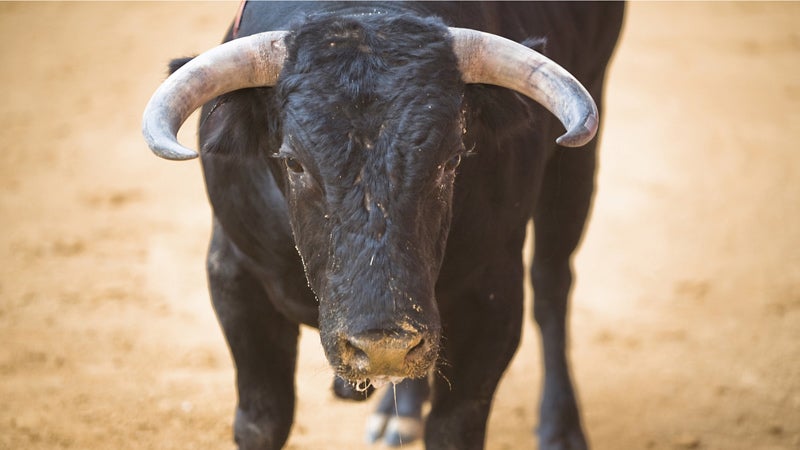
Colombian bullfighting reached its pinnacle in 1991 when el maestro César Rincón’s spectacular performances led to four triumphs over his fellow bullfighters in a single season at bullfighting’s most hallowed ground, the San Isidro Festival in Madrid. On those afternoons, Rincón awed the crowd with gracefully executed passes that included summoning the bull at a full gallop from across the arena and passing it behind his back. He exited through the great door of the ring lofted on the shoulders of the costaleros, Plaza workers who in Spain would traditionally visit the bullfighter at his hotel after the match seeking a tip for the deed. No bullfighter in the world had before exited through the great door in Madrid four times in a single season.
Rincón commentated for Gómez’s debut fight on RCN Radio. Before the toreros entered the ring, the maestro lamented the closing of some dozen Colombian bull ranches in recent years. Family-owned properties where bulls are bred for bullfighting could not sustain continued losses in a declining market.
Aspiring Colombian bullfighters have very little opportunity to train in Colombia today, with fewer bull ranches inviting them to practice and less bullfights. Often, they must train in Spain or Mexico. Gómez’s parents supported him at a bullfighting school in Cali, Colombia for five years. He then spent two years in Guadalajara, Mexico working at a restaurant as he trained.
Bullfighting critic Ivan Parra estimates that a torero hitting all the large and small plazas in the country would be lucky to make $50,000 per year. That doesn’t count the costs of a suit, cape and muleta—which could reach $8,000—and practice bulls. He estimates 85 percent of Colombian bullfighters have other sources of income.
Colombian matador Santiago Naranjo has a retail store at a shopping mall in Bogotá and studies business administration. Another bullfighter, Manuel Libardo, was taken in by a family in Spain and supported by donations from Bogotá aficionados until he could draw income. This year he was named best Colombian matador by a group of three influential bullfighting writers, including Parra, and he says he can support himself via this profession. Few Colombian bullfighters can say the same.
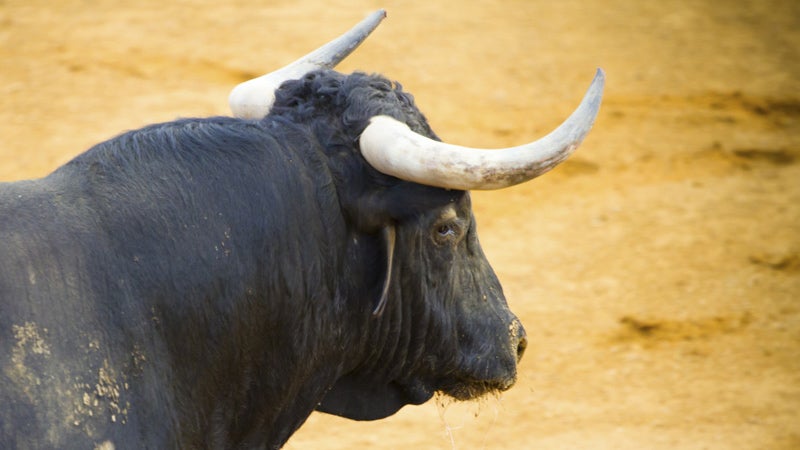
The second round of bulls was highlighted by the Frenchman Castella, who delighted spectators by first summoning the bull from his knees. The 1,164-pound bull passed him three times in this position to the joyous shouts of the crowd. In the first act, the aggressive bull even knocked over a bullfighter on horseback by slamming its enormous girth into the horse’s 220-pound quilted canvas protective coat. Castella proceeded to completely dominate the bull, gracefully passing it in front of his body ever so close that on some left side passes, he reached his right arm around the bull. After the fight, Castella was awarded two ears, for a total of three on the day, his “passport to exit through the great door” explains Parra. At the end of the afternoon, Castella would be lofted on the shoulders of the costaleros for the crowd to toss flowers and their hats to him below.
When Gómez returned to the sand for his second bull, the 1,020-pound Cafetero galloped into the ring. The radio announcers called him the best bull of the afternoon for his fierceness and the way he aggressively stampeded toward the magenta capes. In the second act, a banderillero, a bullfighter who places two spiked sticks in the bull’s shoulders, was knocked to the ground by the charging Cafetero, who tore an 8-inch gash in the man’s calf.
Gómez kept a frigid mind and changed his cape for the red muleta before walking to the center of the ring for the third and final act. There, he knelt on his knees and held out the maleta with his sword, calling for the bull to charge him. The audience shouted in defiance of the young man’s risk. On the day of his alternativa, Gómez had hoped his performance would urge the Plaza president to award him at least two or three of the defeated bulls´ ears for his valor and grace. On the radio, Rincón noted that Gómez had scarcely tested the bull with his magenta came in the first act. The bull ignored Gómez, and to the relief of many onlookers, the young bullfighter changed strategy and stood up.
He lept in the air and called for the bull repeatedly before carefully executing a series of passes that pleased the crowd. Spectators began to shout “Ole!” again and again until the president of the plaza motioned to the band. Trumpets flared to life with the Spanish paso doble written in honor of the Festival of Manizales.
As he was conducting the faena, the beautiful sequence of the bull passing the muleta, Gómez heard the music and filled with joy. He had reached the grand stage of bullfighting, the only Colombian matador to graduate this year via a consensus of bullfighters, ranchers, aficionados, and businessmen.
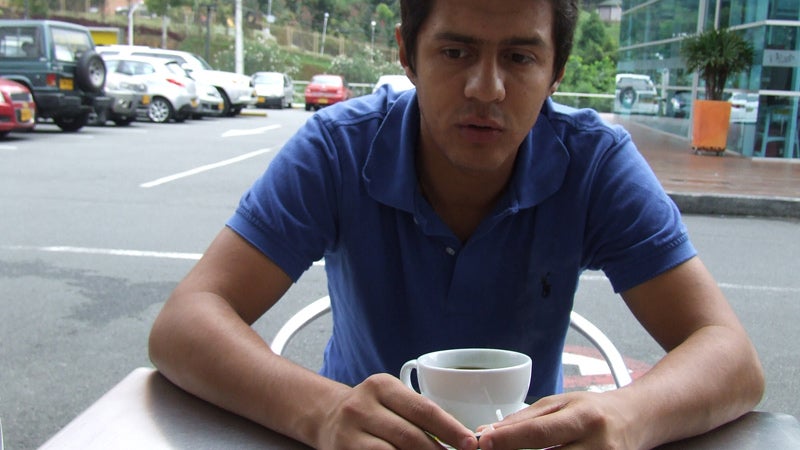
The next morning, however, Gomez was filled with sadness. The young man who had been dressed in a suit of lights wore jeans and a faded blue polo shirt as he reflected on his future over a cup of tinto, black Colombian coffee.
“Now, I am a matador of bulls, and I am left thinking: ‘What am I going to do? Where am I going to go?’” Gómez says. On the future of bullfighting, he couldn’t say whether it would exist in Colombia 10 to 15 years from now, but he said he was optimistic. “I’m of the thinking that when bad things happen, as in the past, people need to unite and find a solution.”
Then, he described a small bullfighting plaza in his home state of Caldas, in the foothills of Colombia’s eastern mountain range, which has been dormant for a decade. The white stucco building with red pillars sits alone in a grassy pasture with a mountainous backdrop. It is like many small plazas and grand arenas across the country where local mayors have conceded defeat to the anti-bullfighting movement, or have simply stopped buying bulls to lower the cost of yearly festivities.
“I think that if there is a plaza, you have to take advantage of it,” Gomez says. “How are we going to do that? We’ll do it ourselves. I get together with another torero and we bullfight. We buy the bulls, and if there’s money to be made, fine. If not, fine. We have to think of how to make it happen ourselves. Say, ‘Come, we’re going to have a bullfight.’”


